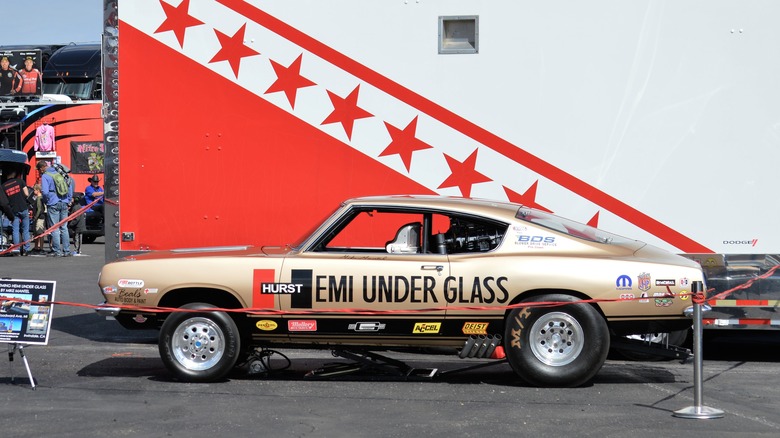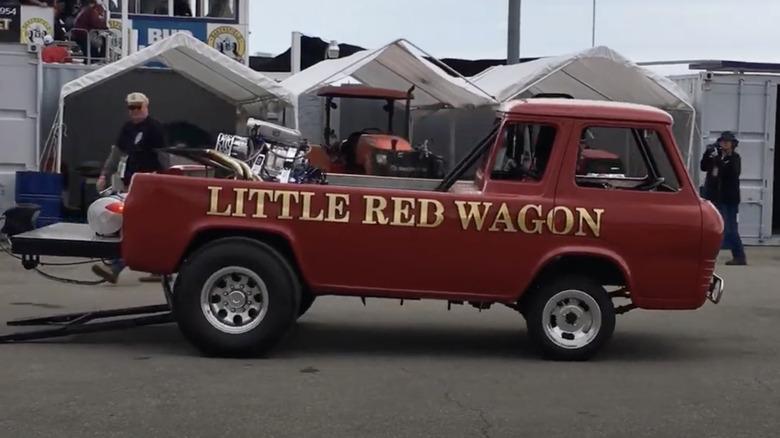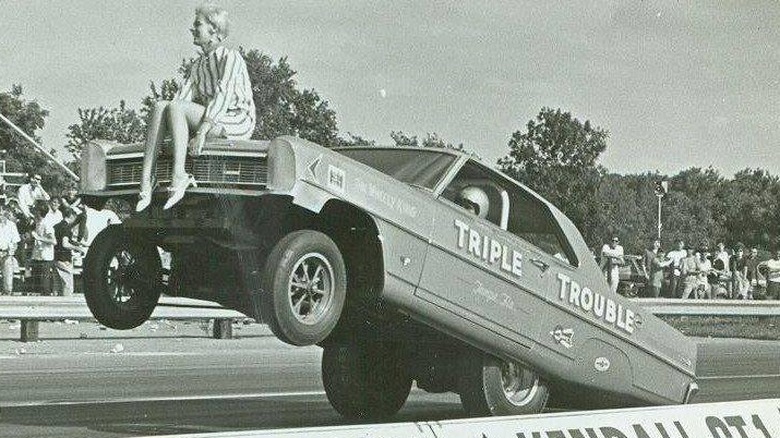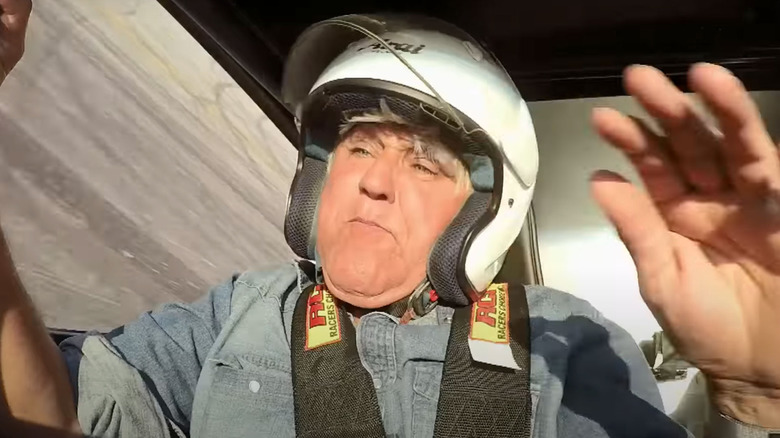All About Hemi Under Glass: The History Of Hurst's Famous Wheelstanders
Chrysler's HEMI engine has been a popular choice for performance-oriented drivers since it was introduced in 1951, thanks to the hemispherical chambers that give the engine its name and allow for a more efficient transfer of combustion energy to the pistons. Six of the ten most powerful factory HEMI engines were capable of producing over 500 horsepower, but an even more powerful version of the legendary V8 was first used in a special one-off car more than half a century ago.
In 1964, Hot Rod Magazine publisher Ray Brock and George Hurst of Hurst Performance had brainstormed about putting a souped-up HEMI in the fastback rear of a Plymouth Barracuda. The HEMI was mounted under a clear canopy and labeled the "HEMI Under Glass." Brock and Hurst enlisted driver Bob Riggle to test their new creation, who popped a wheelie on his first drive. "Boy, they thought that was exciting," Riggle said on an episode of "Jay Leno's Garage." "George was saying to himself, 'I got something here,'" he added. Leno, who was a teenager at the time, had always assumed the car was built to be a wheelstander, but Riggle assured him that Brock and Hurst intended it to be an FX-class race car. Bill Shrewsberry was the first to drive the car at events, but he quickly moved on to drive the "Hurst Hairy Olds."
The Little Red Wagon was the first HEMI-powered wheelstander
Shrewsberry confirmed the HEMI Under Glass' original purpose in a 2008 interview with NHRA.com. "It was never Hurst's intention for the car to do wheelies," he said. "It was more like an experimental car with an experimental shifter." The HEMI Under Glass wasn't even the first accidental hemi-powered wheelstander. That honor goes to the Little Red Wagon, which is not to be confused with the 1978 Lil' Red Express, a hot rod pickup truck. The Little Red Wagon was built in 1964 by Chrysler engineers Jim Schaeffer and John Collier, who cut holes in the cab and bed of an A-100 cabover pickup to mount a 426-cubic-inch HEMI and Torqueflite transmission.
To save weight, the spare tire, heater, front bumper, and dash panel were scrapped, and the steel doors were swapped out for fiberglass ones. It was sold to Bill "Maverick" Golden, who did seven wheelstands during an 11-second quarter-mile run at the 1965 American Hot Rod Association event at Lions Drag Strip outside downtown Los Angeles. During that winter, Golden designed and installed a hand-controlled Hurst disc brake system on the rear wheels, which he used to steer the truck when the front wheels were off the ground.
Builders went wild crafting wheelstanders in the late '60s
The first two Little Red Wagons were either crashed or cannibalized to make the third, and a fourth was built in the 1970s and driven until Golden's 2003 retirement. Over that span, wheelstanders became the NHRA's longest-running exhibition class and featured some of the wildest vehicles ever built.
Tampa's Tommy Stringfield got a jump on the "Florida Man" trend when he put two extra engines in the back seat of a 1966 Chevy Nova and drove the "Triple Trouble" to achieve a wheelstanding record of 4,100 feet at 110 miles per hour. Arnie Frank dropped a fuel-injected 426 HEMI in a 1966 Ford Mustang, which often tipped the car off all four wheels to ride on the casters mounted on its rear bumper.
In terms of the Hemi Under Glass, Shrewsberry handed the keys over to Bob Riggle in 1966 so he could build his own HEMI-powered wheelstander and drive the Batmobile in 1967 for the television series "Batman." Riggle would suffer a horrible accident in 1975 when he crashed at US 30 Dragway and would retire but return in 1992 with a revamped version of the car.
Bob Riggle flipped the HEMI under glass with Jay Leno aboard
The 468 cubic inch HEMI Under Glass was tuned to produce an astonishing 2,500 horsepower, and that was a little too much for Riggle to handle when he took Jay Leno for a ride at the Irwindale Speedway in 2016. Their terrifying rollover crash was featured on an episode of "Jay Leno's Garage," and fortunately, both men walked away unharmed. In fairness to the 80-year-old Riggle, it was only the second accident he's had in 50 years of driving the HEMI Under Glass, and the rear-end heavy car was not meant to ride on two wheels on the banked oval at Irwindale.
While the body suffered significant damage, the engine apparently survived under its clear canopy. The car has since been completely repaired and restored and is now owned by Hurst collector Joe Spagnoli, who also harbors several Indy 500 pace cars in his Chicago-area shop. It's important to note that Mike Mantel took over as the new driver and owner of the 1968 version of the car shortly Riggle retired from driving in 2019, while Spagnoli owns the '69 version. Riggle died in September 2023 at the age of 88.



